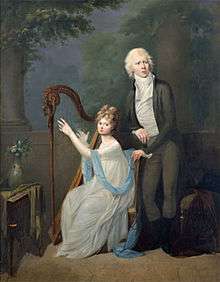Duchess Louise Charlotte of Mecklenburg-Schwerin
| Duchess Louise Charlotte | |
|---|---|
| Hereditary Princess of Saxe-Gotha-Altenburg | |
 Louise Charlotte, Hereditary Princess of Saxe-Gotha-Altenburg and her husband, by Alexandre Molinari, Galerie Neue Meister, Dresden. | |
| Spouse(s) | Augustus, Duke of Saxe-Gotha-Altenburg |
|
Issue | |
|
Titles and styles
HH The Hereditary Princess of Saxe-Gotha-Altenburg HH Duchess Louise Charlotte of Mecklenburg-Schwerin | |
| Noble family |
House of Mecklenburg-Schwerin (by birth) House of Saxe-Gotha-Altenburg (by marriage) |
| Father | Frederick Francis I, Grand Duke of Mecklenburg-Schwerin |
| Mother | Princess Louise of Saxe-Gotha-Altenburg |
| Born |
19 November 1779 Duchy of Mecklenburg-Schwerin, Germany |
| Died |
4 January 1801 (aged 21) Gotha, Germany |
Duchess Louise Charlotte of Mecklenburg-Schwerin (19 November 1779 – 4 January 1801) was the maternal grandmother of Prince Albert, husband of Queen Victoria of the United Kingdom.
Louise Charlotte was born a Duchess of Mecklenburg-Schwerin, her father being Friedrich Franz I, Grand Duke of Mecklenburg-Schwerin. Her mother was Princess Louise of Saxe-Gotha-Altenburg and her sister Charlotte of Mecklenburg-Schwerin (1784–1840), who married King Christian VIII of Denmark.
Life
On 1 November 1795, Louise Charlotte was engaged to King Gustav IV Adolf of Sweden. The engagement was arranged by Gustaf Adolf Reuterholm, the de facto regent of Sweden, who wished to keep his influence after the monarch was declared of legal majority by having a queen indebted to him for her position. The king himself was initially positive; the engagement was celebrated in the courts of Sweden and Mecklenburg and Louise Charlotte was mentioned in the official church prayer in Sweden. Empress Catherine the Great, however, wished her grand daughter Grand Duchess Alexandra Pavlovna of Russia to be Queen of Sweden, and displayed dislike of the engagement. Upon this many people told the king that Louise Charlotte, whom he had not seen, was not beautiful. About the same period, the monarch also fell in love with Ebba Modée. When the king was declared of legal majority in 1796, he broke off the engagement. Her father demanded compensation. In 1803, the matter was settled when the Swedish city of Wismar in Germany was turned over to Mecklenburg-Schwerin by a treaty in Malmö.
In Ludwigslust on 21 October 1797 she married Augustus, Hereditary Prince of Saxe-Gotha-Altenburg, a second cousin on her mother's side. Their common ancestor was Frederick II, Duke of Saxe-Gotha-Altenburg (1676 – 1732). The marriage was arranged against her will and was an unhappy one: her spouse abused her and she wished to leave him, but was forced by her family to stay.[1] She was described as very blond, not attractive, somewhat hunchbacked but also as witty, talented, cultivated and with a pleasant manner, though more open than what was regarded as an ideal for the period.[2]
Three years later, on 21 December 1800 in Friedenstein Castle around 12.45 pm[3] the Hereditary Princess of Saxe-Gotha-Altenburg gave birth her only child, a daughter, named Louise after her; this daughter later became the wife of Ernst I, Duke of Saxe-Coburg and Gotha, and mother to Prince Albert, Prince consort of Queen Victoria. However, she never recovered from childbirth effects and died eleven days later, on 1 January 1801 at the age of 21, before Augustus assumed the throne of Saxe-Gotha-Altenburg.
Titles and styles
- 19 November 1779 – 21 October 1797: Her Highness Duchess Louise Charlotte of Mecklenburg-Schwerin
- 21 October 1797 – 4 January 1801: Her Highness The Hereditary Princess of Saxe-Gotha-Altenburg
Ancestry
References
- ↑ Cecilia af Klercker (1936). Hedvig Elisabeth Charlottas dagbok VII 1800-1806 (The diaries of Hedvig Elizabeth Charlotte VIII 1800-1806) (in Swedish). P.A. Norstedt & Söners förlag Stockholm. p. 63.
- ↑ Cecilia of Klercker (1936). Hedvig Elisabeth Charlottas dagbok VII 1800-1806 (The diaries of Hedvig Elizabeth Charlotte VIII 1800-1806) (in Swedish). P.A. Norstedt & Söners förlag Stockholm. p. 63.
- ↑ Harald Sandner: Das Haus Sachsen-Coburg und Gotha 1826 bis 2001; Eine Dokumentation zum 175-jährigen Jubiläum des Stammhauses in Wort und Bild. Printing and publishing Neue Presse, Coburg 2001.
- http://www.nordicacademicpress.com/o.o.i.s?id=43&vid=860 (in Swedish)
- http://historiska-personer.nu/min-s/pf8c1f73f.html (in Swedish)
- http://runeberg.org/sqvinnor/0274.html (in Swedish)
- Torbjörn Nilsson : Guide till Sveriges historia i Europa (in Swedish)